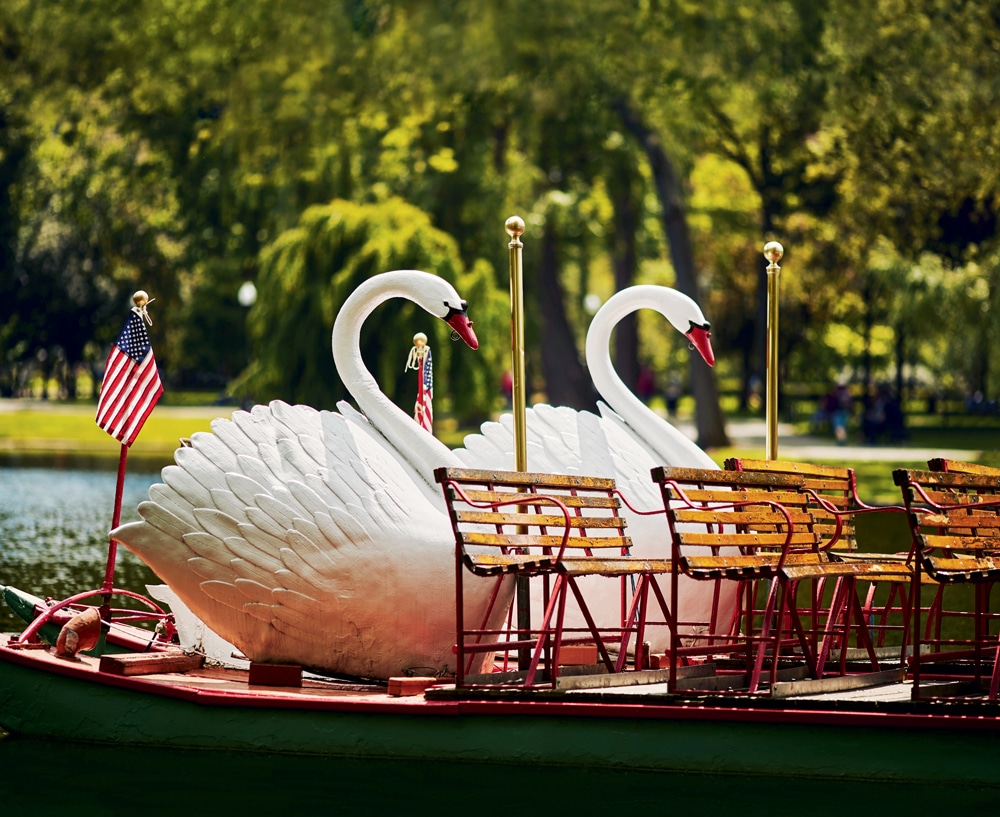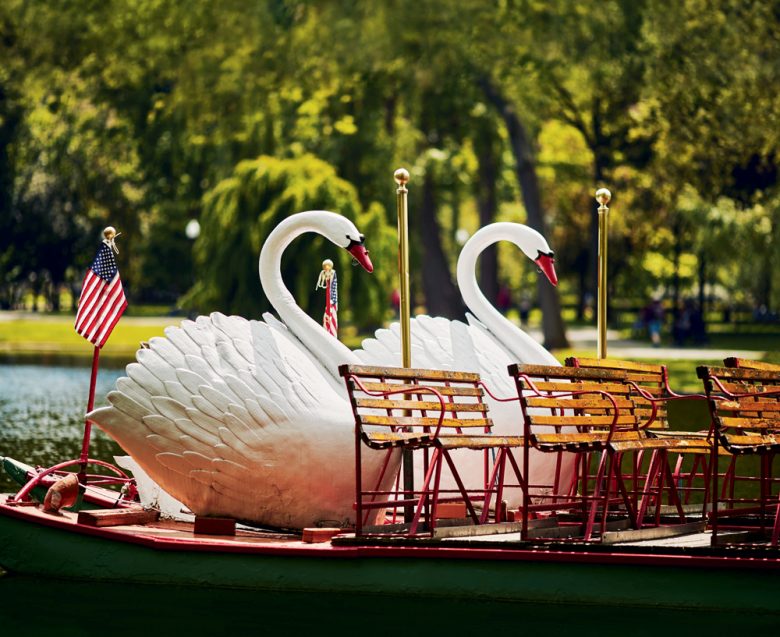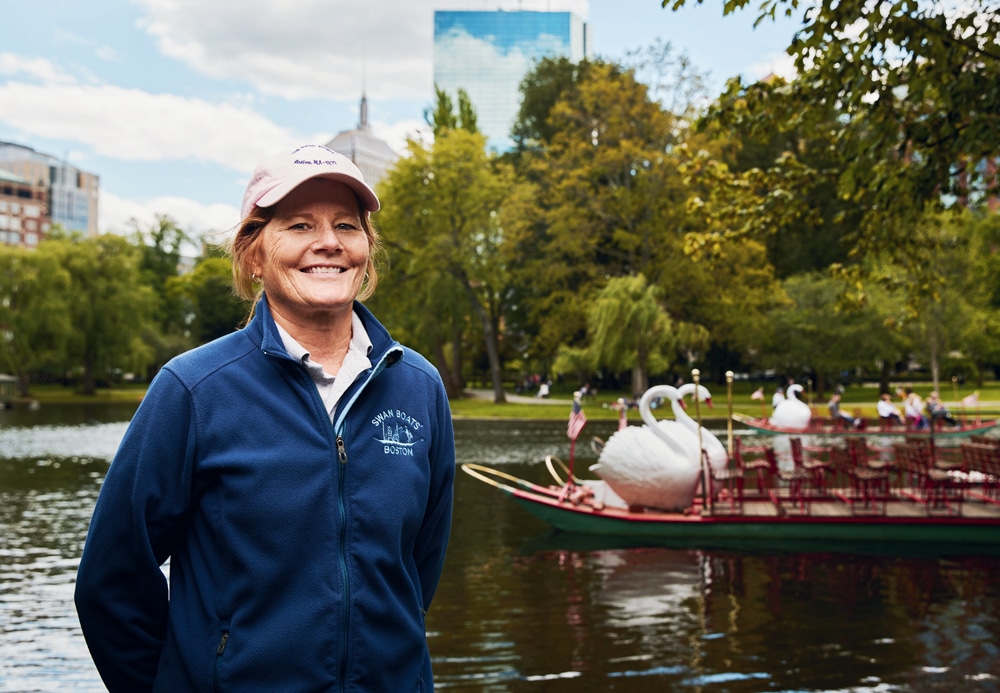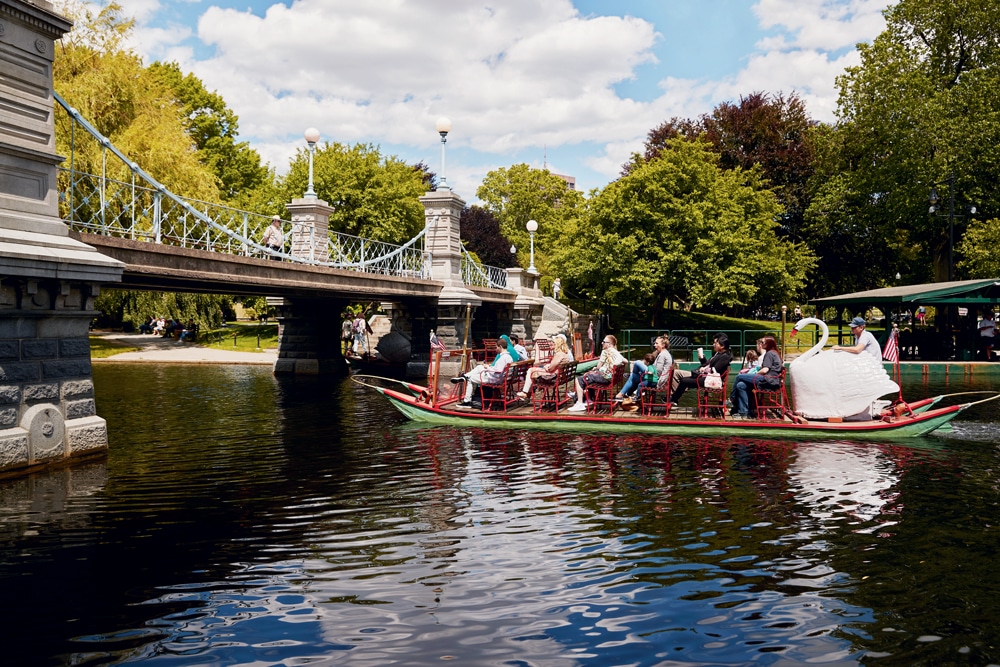Boston Swan Boats | Back in the Paddle
For generations of Bostonians, spring begins when the Swan Boats first set out across the Public Garden lagoon.

2020 marks the 144th season for Boston’s Swan Boats, which have been gliding around in the Public Garden since Rutherford B. Hayes was in the White House.
Photo Credit : Emily KanDating back to 1837, Boston’s Public Garden is rooted on land once submerged in tidal marshes. Victorian cast-iron fencing skirts the 24-acre enclave that sits alongside Boston Common in the heart of downtown, surrounded by the historic neighborhoods of Back Bay and Beacon Hill and not far from the Financial District and the waterfront. Within the Public Garden is a six-acre pond, and it is here that the city’s famous Swan Boats make their nest. Ornamented with replicas of their graceful namesake, these 30-foot-long pontoon boats have endured the Depression, two world wars, East Coast weather, and the Internet age.

Photo Credit : Library of Congress
Knowingly or not, many Bostonians hold the Swan Boats as a serene constant in the city’s endless flux. I am one of them. I rode the boats as a child; so did my mother and her mother, and so did my father and his mother. To my 7-year-old self, the swan perched on the stern loomed tall, its neck curving like half a cartoon heart. The surface of the wide lagoon was flat except for the dappled path left by the boat’s paddle wheel. A 7-year-old and her three siblings might have wished they had rocks to toss into the water, making a kerplunk like the blueberries hitting a metal pail in Robert McCloskey’s Blueberries for Sal. The same author wrote Make Way for Ducklings in 1941, which helped immortalize the Swan Boats and the Public Garden for generations of young readers.
Today, I have come back to the Swan Boats right at that annual moment when early May explodes into spring: sunlight, greenery, and pollen. It’s been two decades since my last loop on the Swans. I no longer thrill at the thought of falling in (the water is two feet deep), and what I recalled as a 40-minute jaunt around the pond actually lasts about 15. But the urge to sit on a swan on the water is there, a trinket of childhood that endures.

Photo Credit : Emily Kan
There are no phone calls allowed here. There are no waterfalls or statues to ogle. There are puttering ducks, and pennies winking beneath the silt. Under a stone footbridge near the water is a spill of yellow tulips like cracked egg yolks. A willow tree dangles long ropes of frondlike branches over benches and grass. The hum of Commonwealth Avenue is eclipsed, somehow, by quiet.
Weighing some 800 pounds apiece and built mainly from oak, iron, and copper, the Swan Boats have the same basic design today as the very first versions, launched more than 140 years ago. Most of the boat is filled with benches that hold 25 passengers. At the stern is the driver, who seemingly perches on the back of a swan while peddling, bicycle-style, to turn the paddle wheel; steering is done with a rope attached to the rudder. The 12 boats in the fleet are all painted, sanded, and revarnished seasonally, with workers taking care to maintain the two dozen or so parts custom-made for the Swans, the oldest of which is 109. Weather permitting, the Swan Boats operate daily from mid-April through Labor Day; an adult ticket costs less than a small latte at any of the nearby coffee shops.
Standing under the awning of the pontoon dock is owner Lyn Paget, the great-granddaughter of Roger Paget, the original proprietor. Her smile is like the mellow flicker of sun on the water, and despite her petite size there’s also something about Lyn that suggests she could hoist two adults from knee-deep water if she wanted to.

Photo Credit : Emily Kan
The Swan Boat family tree is as neatly vertical as a birch. Lyn’s father, Paul Paget, took the reins from his father, John Paget, who was 86 when he retired. John’s parents, Irish immigrants named Robert and Julia Paget, debuted the Swan Boats in 1877, seven years after getting a rowboat license from the city council. When Robert died the following year of tuberculosis, Julia, pregnant with her fourth child, took over as sole proprietor. Being a woman, she was required to collect signatures from fellow Back Bay business owners as proof that she had the ability to run the Swan Boats—which she went on to do for 36 years.
“Sitting here 143 years later,” Lyn tells me, “there’s no way this would have continued to exist without her.”
Visitors trickle toward the dock awning as lunchtime approaches. Sue Ferruggio, who has worked at the Swan Boats for 24 years, collects tickets from a father-daughter duo from Arlington, a family of six from Maine, travelers from China visiting relatives, and a grandmother who once rode the boats as a girl with her grandmother.

Photo Credit : Emily Kan
I ask Lyn if she has any indelible memories from her life among the Swan Boats. I suppose I expected a family anecdote, or a nod to returning patrons for whom a boat ride is a decades-old tradition. But what she said was, “I feel so emotionally connected to what the boats mean for people. And that was especially apparent during the Boston Marathon bombings in 2013.”
Even from the lagoon, she remembers, they could hear it. A loud noise. Commotion. Sirens. That evening, the parks commissioner left it up to Lyn to decide whether to open the Swan Boats in the following days. She called every member of her close-knit little crew to see where their hearts and heads were. The consensus was unanimous: “One hundred percent of our team told me, ‘We’re in.’”
The Swan Boats reopened two days after the marathon bombings. Locals showed up. Folks who were stuck in town without a flight home showed up. People still wearing running numbers and medals showed up. “It was amazing to see how many people flocked here,” Lyn says.
Not long after that, Lyn was making small talk with a woman whose son was on the dock, in a wheelchair, waiting for his boat ride. Their family had flown from California for the marathon, which the woman ran in. Her son had been at the finish line and was hit in the leg by shrapnel when the bombs went off. The boy spent a week recovering at Boston Children’s Hospital, and this was the first day since the bombings that he had medical permission to go outdoors. He asked for a Swan Boat ride.
Lyn pauses. We both nod in the silence, unintentionally mimicking the bobbing Swans behind us.
“It’s an incredible memory of human love and persistence,” she says. “A memory like that shows what these places in the middle of cities are to people. They mean something.”
A pause, and then: “They mean something.”


